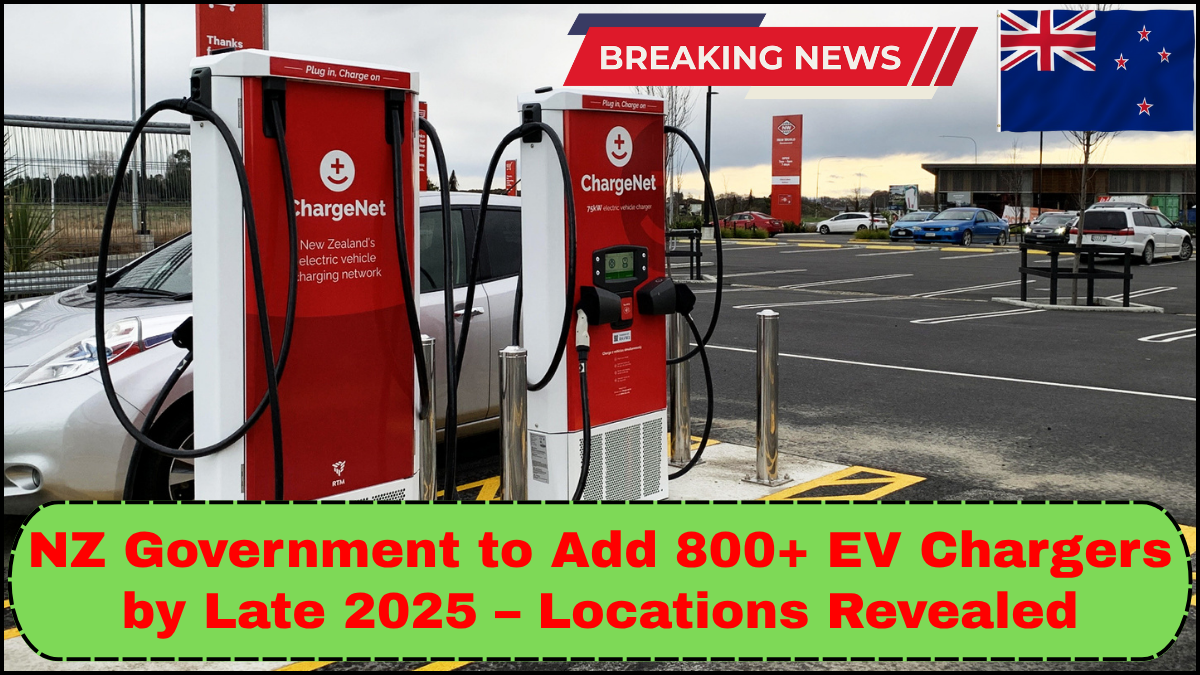New Zealand is charging ahead with its electric future. Under the NZ EV Charger Expansion Plan 2025, the government has announced the installation of over 800 new electric vehicle (EV) chargers nationwide by the end of next year. This strategic initiative is aimed at closing infrastructure gaps, encouraging EV adoption, and supporting the country’s climate goals.

A Bold Infrastructure Move
As part of its broader sustainability agenda, the New Zealand Government is making a significant push to accelerate the transition to electric mobility. The plan, backed by substantial govt funding, is expected to boost the number of public EV charging stations by over 60%.
The announcement was made by the Ministry of Transport in coordination with EECA (Energy Efficiency and Conservation Authority), which will oversee the rollout. The investment comes at a critical time, with EV registrations in NZ growing steadily year-over-year. However, limited charging infrastructure has remained a major bottleneck.
Where the Chargers Are Going
The new chargers will be strategically placed to ensure nationwide accessibility. Here’s how the distribution breaks down:
- Highways and Major Routes: Over 300 chargers will be installed along State Highways to ensure that no driver is more than 75km away from a fast charger.
- Regional and Rural Towns: About 200 chargers are planned for underserved rural communities to address equity in EV access.
- Urban Hubs and City Centers: Approximately 250 chargers will be added in metro areas like Auckland, Wellington, and Christchurch to support growing demand.
- Tourism Destinations: Key travel locations such as Rotorua, Queenstown, and the Coromandel will also receive installations to support eco-tourism.
These locations were selected based on traffic data, population density, and input from local councils and transport agencies.
Types of Chargers Being Installed
The deployment will include a mix of fast chargers (DC) and standard chargers (AC) to cater to different needs:
- DC Fast Chargers (50kW to 150kW): Ideal for highway rest stops and busy urban locations where drivers need a quick recharge.
- AC Chargers (22kW): Best suited for shopping centers, hotels, and parking buildings where cars remain parked for longer periods.
Why This Matters
This expansion isn’t just about convenience — it’s a cornerstone of New Zealand’s goal to reach net-zero emissions by 2050. Transportation accounts for nearly 20% of NZ’s carbon emissions. Widespread availability of charging infrastructure is crucial to overcoming “range anxiety,” a key barrier to EV adoption.
The electric vehicle charging NZ network is currently patchy, especially outside major cities. The 2025 plan aims to eliminate these “blackout zones” and make EV ownership a viable option for all New Zealanders.
Govt Funding and Private Partnerships
The project is being funded through a combination of public investment and private sector collaboration. The government has earmarked over $50 million from the Low Emission Transport Fund, with additional contributions from regional councils, energy companies, and commercial partners.
Private sector involvement is critical for scalability. Charging network operators like ChargeNet, Z Energy, and Vector are among the key players involved. This blended funding model helps ensure long-term operational sustainability and competitive pricing.
Long-Term Benefits
- Economic Growth: The expansion will create jobs in engineering, construction, and maintenance.
- Public Confidence: Improved infrastructure increases consumer confidence in switching to EVs.
- Environmental Impact: More EVs on the road mean lower CO2 emissions and better air quality.
- Tourism Support: EV-friendly travel options boost green tourism opportunities.
What to Expect Next
The installation process is already underway, with the first wave of chargers expected to be operational by early 2025. A dedicated online map will be updated monthly to show live installation progress and availability.
The NZ EV Charger Expansion Plan 2025 will also feature educational campaigns to guide users on how to locate and use public chargers, further smoothing the transition.
FAQs
Q: How many chargers will be fast chargers?
A: Around 60% of the new chargers will be DC fast chargers, catering to long-distance travelers and busy urban locations.
Q: Will the new chargers be free to use?
A: Most chargers will be pay-to-use, with pricing set by the operators. Some councils may offer free or discounted charging during off-peak hours.
Q: How can I find a charger near me?
A: A real-time map will be available on the EECA and NZTA websites, showing the status, type, and availability of chargers.
Q: Are there any incentives for businesses to host chargers?
A: Yes. The government offers co-funding and tax incentives for businesses that install public EV chargers.
Q: What happens after 2025?
A: The plan is part of a longer-term vision. The government intends to reassess infrastructure needs annually and expand based on future demand.
click here to learn more